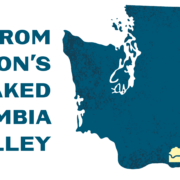Why not Enjoy a Nice Petite Sirah. Take and Deep Dive and a Sip.
Petite Sirah is sometimes confusing, so let’s settle its secrets once and for all. There is a similarity in the name Petite Sirah and Syrah. Besides their names, they are distinct in their own right. Petite Sirah is not a baby of Syrah. This wonderful varietal’s characteristics are unique and have a different taste profile. It is dark, bold, and rich with ample tannins giving it an excellent aging potential. It is not uncommon to age twenty to forty years in the cellar and will jump out of the bottle with flavors that are as fresh and vibrant as they were when they first went in.

Petite Sirah, a grape called Durif was discovered in France in the 1860s by the botanist Francois Durif. In his greenhouse, a Syrah vine crossed with Peloursin during pollination, resulting in a small, intensely colored berry high in tannins and acidity. Eventually, the vines made their way to California, where winemakers recognized the grape had many similar features to the Syrah they knew well. While they realized the grape was not Syrah, Petite Sirah was a much more attractive name than Durif, so that’s what they began calling it.
It is best described as a dry red wine with some residual sugar after the conversion to alcohol but does not translate into sweetness in the wine. Petite Sirah is one of the darkest red wines produced worldwide and is full of distinctive ripe fruit flavors of plums and blueberries. In addition, hints of dark chocolate, pepper, black tea, licorice, and mocha are also common. Not surprisingly, the wine’s terroir is influenced by differences found between French or cooler climate-produced wine compared with warm climate Petite Sirahs. Petite Sirah from cooler temperatures have more earthy flavors and citrus notes, while warmer climate versions have more decadent, jammy flavors and higher alcohol.
When it’s time to serve the wine, decanting and allowing it to breathe for at least two hours is recommended. A perfectly aged Petite Sirah will mellow, permitting the complexity of flavors to evolve.
Now that you have your wine, think beef! Rich, red protein and Petite Sirah are a perfect love/flavor match! It does not matter how the meat is prepared and cooked; it will always taste better with a glass of this brilliant red wine. Don’t forget the cheese course! The high level of tannins in Petite Sirah makes it an ideal match with creamy, soft cheeses like Camembert, Brie, Mozzarella, Emmental, or Gouda. It is delicious with Raclette or Fondue, which showcases pungent melted Swiss cheese.

For a luxury experience in a bottle, pick up the 2018 Stags’ Leap Ne Cede Malis Estate Grown Napa Valley Petite Sirah. $160
This highly pointed wine comprises 85% Petite Sirah and 15% other varieties. In the glass, it shows deep garnet to purple. On the nose, aromas of black plum, fruitcake, and black cherry jump out to the glass, with hints of truffles on the back end. On the palate, it is medium-bodied with big, bold tannins and tons of muscular fruit with a long finish.
Charles Krug 2018 Limited Release Petite Sirah. $75.00

This Limited Release Petite Sirah from the estate vineyards in St. Helena and Yountville aged in French oak barrels for 18 months before release, giving it an elegant soft mouth feel. This 2018 shows a complex nose of blueberries and warm spices with hints of coffee beans and cocoa powder. On the palate, flavors of cranberry, blueberry, coffee bean, and toasted oak combine with big tannins and a long finish.
Caymus-Suisun Grand Durif 2018 (aka Petite Sirah) $60.00

This Petite Sirah still has the classic flavors the varietal is known for but with a lighter body in the glass. The nose features soft notes of blueberry, blackberry, and coca. Big, bold dark fruit flavors confirm the nose and finish with soft, opulent tannins.
These are all exceptional examples of this little-known varietal and well worth a place at your table.







